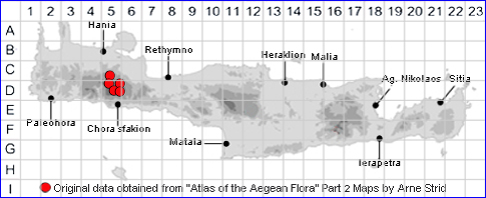
SPECIES DESCRIPTION
DIANTHUS SPHACIOTICUS
Family:- CARYOPHYLLACEAE/Subgen. DIANTHUS
Common Names:- None
Synonyms:- None
Meaning:- Dianthus (Gr) Zeus'-flower. a name used by the Greek philosopher
Theophrastus.
Sphacioticus (Gr) Damaged-looking, of gangrened appearance.
General description:- Small, hairless perennial.
Stems:-
1) A stout, vertical woody stock producing several short, non-flowering shoots and
a few procumbent to ascending.
2) Usually simple flowering stems 3-10(-15) cm.
Leaves:-
1) Basal and those of non-flowering shoots oblong-lanceolate to narrowly elliptical,
subobtuse, rather thick, greyish-green to glaucous.
Flowers:-
1) Solitary.
2) Epicalyx-scales, usually 6, c. 1/3 as long as the calyx; outer ovate and leaf-like;
inner obovate, cuspidate.
3) Calyx, 14-18 mm, tapering from below the middle.
4) Petal-limb, 3-4 mm, obovate, subentire to dentate, hairless, pale pink, bearded.
Fruit:-
Key features:-
1) Leaves on the flowering stems narrower than on non-flowering stems, shorter
than the internodes.
2) Stock stout.
3) Calyx tapering upwards from below the middle.
Habitat:- Rocky flats and calcareous screes, 1700-2200(-2400) rn, with Hypericum
trichocaulon, Lomelosia sphaciotica, phaglalon pygmaeum, etc.
Distribution:- Endemic to the Lefka Ori. Rare.
Flowering time:- Late June to mid-Aug.
Photos by:- Christopher Cheiladakis
Status:-
Conservation status (for threatened species): Vulnerable (V) according to the Red
Data Book of Rare and Threatened Plants of Greece (1995).
Vulnerable (V) according to IUCN 1997.
Protection status (for threatened species): Greek Presidential Decree 67/1981.
